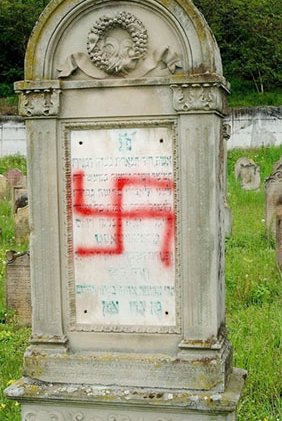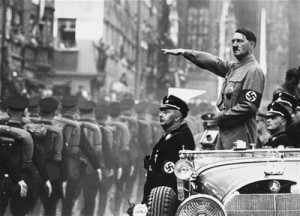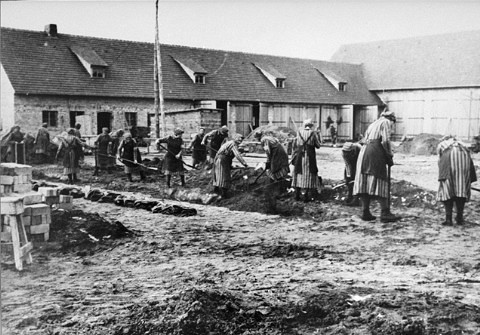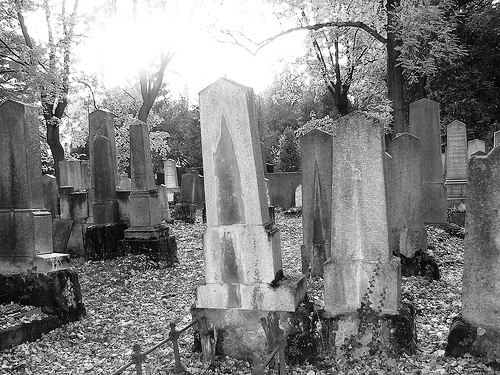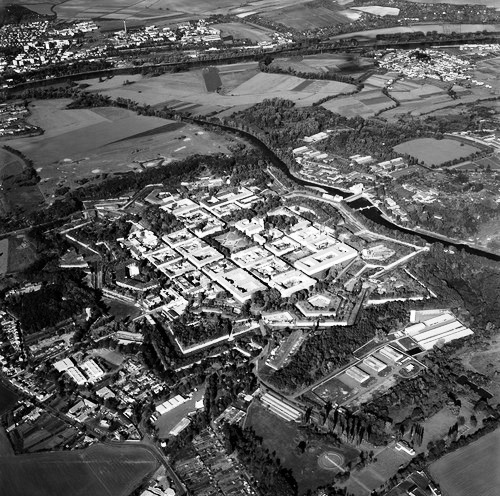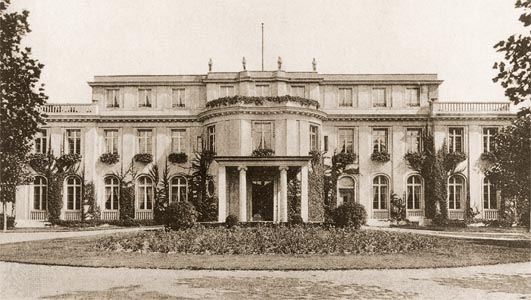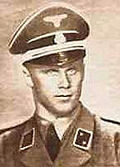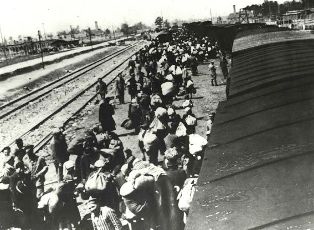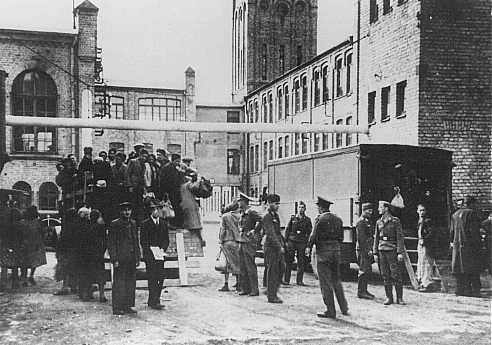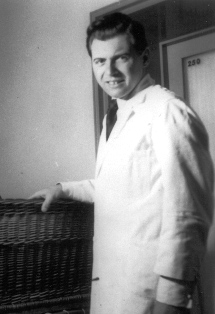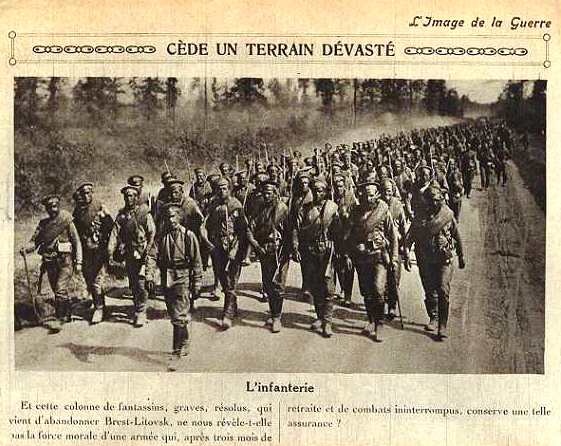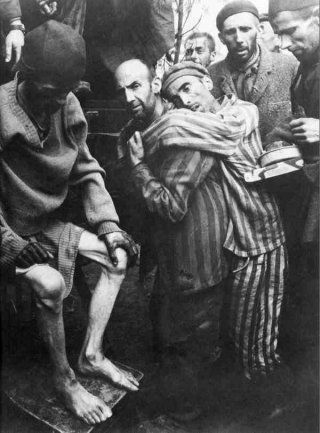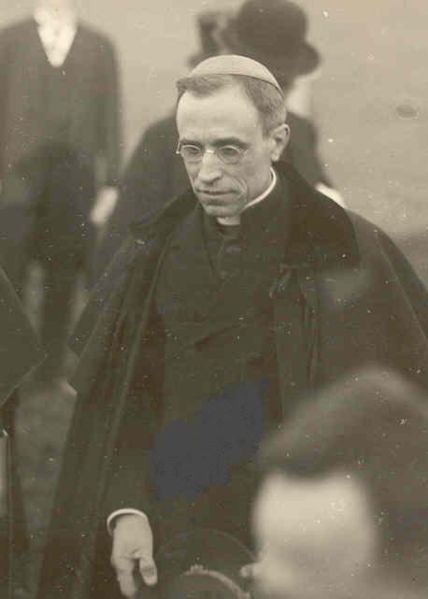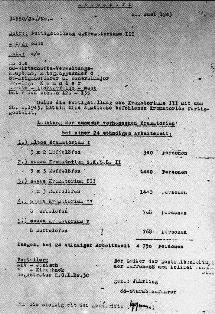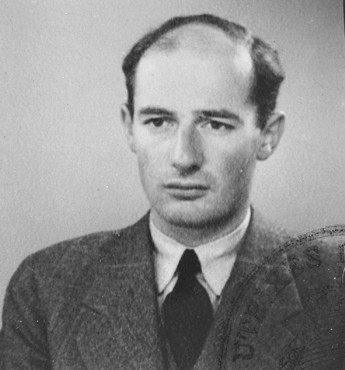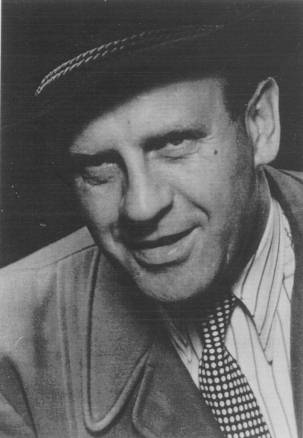Holocaust Education & Archive Research Team |
|
Essays & Editorials Student Essays A brief narrative on the 2006-09 essays by Matthew Feldman 2008 - 2009 2007 - 2008 2006 - 2007 H.E.A.R.T Editorials | ||||||||||
“A Guided Tour of the Sydney Jewish Museum” by David Benedikt First offered September 3, 1999, periodically revised since. [photos added to enhance the text]
First of all, the word itself – anti-Semitism – is a total misnomer. It’s simply a polite way of saying what it actually means: Jew hatred, anti-Semitism has racial overtones: ‘Semite’ – Arabs are also Semites, so the phrase ‘antisemitism’ obviously doesn’t apply to anyone else except the Jews. It is an agreed modern term that was coined to give a pseudo intellectual title to an ugly word which is the descriptive word ‘Jew hatred’.
The consequence of the church having repeated over practically two thousand years from generation to generation the accusation that the Jews were involved with the death of Jesus was this estrangement of the Jews from the people among whom they have lived since the dispersion. This constant repetition eventually resulted in this ‘otherness’ not because of a difference in religious belief but because of this accusation that was maintained by the churches all along.
It was only in 1963 – that was the first time that we had a pope, John XXIII, who had the courage to issue an official Vatican document exonerating the Jews once and for all of that accusation. The consequences of this estrangement, that ‘otherness’ felt towards Jews, is the level of anti-Semitism, the level of dislike, that the Nazis found prevailing at the time when they took power in 1933. The basis for what eventually started to happen after the Nazi take-over in Germany is this prevailing dislike. Dislike eventually leads to fear, fear eventually results in hatred. Hatred results in violence. Unfortunately, we humans react that way.
The difference between the prevailing dislike of Jews and the Nazi structure imposed on the German-speaking Europeans since the take-over of the Nazis in ’33 is distinct. Nazidom, the Nazi ideology is that they intend to plan for the achievement of the cultivation of a super race, a race of super men, a German, Aryan master race which would form an exclusive strata of humanity. This was to be arrived at the way you breed horses in a stud. Race horses are bred by eliminating those generations of horses, as you breed them, which are not capable of being trained as race horses until you arrive at a superior number of horses which lend themselves to being trained as race horses.
This mad idea was to be applied to the generation of German-speaking Europeans until they had achieved this superiority. Not only would the result be that they would all be six foot tall, blue-eyed and blond but they would have such exclusive qualities after that breeding process, after the exclusion of the inferior races, that this in itself would entitle them to rule the world for a thousand years.
Just beneath that strata of superior, master race individuals there would be those whom they called in German ‘Werktiere’ labouring individuals, animals of burden, so to say. They would be left alive. They would be inferior racially speaking but would be entitled to do the menial work for the master race. These would be the second layer of the slightly flawed ones and the bottom layer would be the ‘disposable individuals’ headed by the Jews and the Gypsies, the homosexuals and their own, pukka, German, mentally and physically handicapped. Suffice to say at this stage (as we come back to it later) mass murder by the Nazi structure was applied first to their own German, mentally and physically handicapped. You must think in those degenerate terms of a superiority to be achieved for which you could not include flawed individuals. I don’t have to remind you that in a civilized society it is the responsibility of the community and the State and it is to be taken deadly seriously, that we make sure that the handicapped enjoyed life to the fullest possible extent, but this is in a normal society. When we speak of Nazi Germany we are not speaking of a normal society.
How did they achieve acceptance for such an ideology? The methodology was simple: everyone was put into a uniform which everyone had to wear. Everyone was made to attend mass meetings and at those mass meetings, from those balconies, that ideology is pumped into the population and we find a strange situation. Every neighbor is watching his neighbor, making sure that he too is conforming and attending those mass meetings.
Pressure is exerted from the top for this to take place. Over a period of time we find a general acceptance because mass murder cannot be practiced unless there is a silent, passive acceptance of this murderous ideology. This is the method. It is left over a period of time to find passive acceptance and to sink in. So from 1933 to 1935 this process is taking place in Germany and in Austria who joined them with great enthusiasm in March 1938. Round about 1935, in a place called Nuremberg, a city in Germany, the racial laws are promulgated. The racial laws are there to help distinguish between one individual and another to start the process of separation, of pushing out Jews form the general community. That was the initial stage of this process.
To give you a very condensed and abbreviated idea of the content of the racial laws, if you had a grandmother or grandfather who was traceably Jewish, it was enough for you, two generations later, to become an object of persecution. These were roughly the German racial laws introduced in 1935. Signs appeared all over Germany asking people who had anything to do with Jews not to associate with them, to kick them out of the general community, to isolate them simply because the accusation was that they were the misfortune of the German people. Again time was allowed for this to sink in, for this to become somehow passively acceptable until we come to the first definite date of the holocaust, the first outbreak of organized violence against Jews on the night from the 9th to the 10th November 1938 which was called the ‘night of broken glass’ or in German, ‘Kristallnacht’.
Every business premises owned by Jews whether they were shops, factories or even residential quarters were broken into and looted throughout Germany and Austria. Every Synagogue throughout Germany and Austria was burnt to the ground no matter how close it was to people’s dwellings as a symbolic act and 90 odd Jewish people were killed in the streets and 11,000 taken away to the very early concentration camps that the Nazis established in Germany. The names won’t mean much to you: Ravensbruck and Buchenwald and Bergen Belsen and Dachau. These were the early concentration camps.
Now Jewish people in Europe had a previous experience of persecutions. In eastern Europe it was known that, occasionally there were outbreaks, on a relatively small scale, of persecutions of Jews. How did they react to it? Thy adopted a practical way of escaping, of getting out of the situation. They took a suit case and left their possessions behind and went elsewhere where they were left alone and where they could start from scratch. And these were the early reactions to persecution in Germany.
Long queues formed in front of embassies and consulates all over Germany and Austria of Jewish people begging to be let out, to emigrate. Unfortunately, coinciding with this very dire necessity was the introduction in the whole of the free world of immigration quotas. What is an immigration quota? The limited number of people that would be let in over, say, a calendar year. And so, in the so-called free world, in Canada, America, Australia and New Zealand these immigration quotas are introduced in the late 1930s when this critical situation started.
I have at home to this day a photocopy of a letter which my father received from the American consul in my birthplace (I advisedly don’t call it my home town) in which my father is notified that his application for immigration to the United States has been duly received and he is herewith notified that the immigration quota for 1939 was full up and he would have to wait for the following year for another occasion. By that time, the war had broken out (on 3rd September 1939 exactly sixty years ago today) and the Jews were trapped. There were no appreciable numbers able to escape after that date.
We come now to a concept that needs explanation, the word ‘ghetto’. It is an Italian word which goes back to the middle ages, to the fifteenth century roughly or even before and the meaning of the word in Italian is a foundry: a factory where you melt metal and make things from it. It so happens that in a part of Venice there was a foundry and a lot of Jewish people lived in the vicinity of the foundry, so instead of calling it a Jewish quarter, they called it the foundry quarter.
The Nazis 350 years later took this concept and imprinted this on those run-down suburbs which they set aside to force the Jews into, surrounded with brick walls and barbed wire and armed guards and created conditions for people to live in that started to become conducive to them dying from lack of food supplies, lack of hygiene. You need to imagine, if you can, seven families in a two roomed flat. I am not speaking of a two bed-roomed flat, I am speaking of a two room flat. With seven families living in such a situation the conditions created are such that people start to die over a period of time.
Not only did the Jews have to build those walls around those ghettoes themselves, they had to pay for them as well. A ghetto is defined as “…an urban section serving as a compulsory residential quarter for Jews…” Just in case they should have an opportunity to be in touch with the surrounding population, every Jew had to wear a yellow star with the word ‘Jew’ imprinted on it and as the Nazis occupied more and more of Europe, so the word ‘Jew’ appears in the languages of the countries the Nazis occupied. So you’ve got for example the word ‘Juif’ which is French. The word ‘Jood’ which is Dutch and so on.
Now I’m going to tell you something that you will not be able to understand and just be grateful that you don’t. You are fortunate to have grown up in normal circumstances in a free country with a free system of government and with normal people around you. Don’t worry about not being able to adapt your mind set to what I’m going to tell you now. It’s not possible for normal people. What you’re going to see as you go around this museum in photos, in blow-ups or even in short films on the monitors. If it’s in black and white and not in colour, it comes from German propaganda material, from Nazi archives that they established.
There wasn’t anyone else to take these photos except they themselves. That they established these archives showed that one day they could with great pride show their future generations of children and grandchildren how they rid the world of the Jews. This is what you will see in black and white. Only material taken in colour is contemporary. And these are the photos they took of their handiwork. This is exactly what they achieved and what they wanted to commemorate.
This is a map of central and eastern Europe. It shows the locations of 150 of the 500 ghettos the Nazis established in that area, mainly in Poland and the Baltic States. There are two main reasons for this: firstly, the largest number of Jews in Europe prior to World War II – 3.3 millions – lived in Poland. They constituted 8% of the population then. (In Germany Jews constituted 0.5 or one half percent of the population, by comparison).
It will give you an idea of what we speak of, when quoting the consequences of the Holocaust, when we are told that that figure of 3.3 millions had reduced to 4700. The other reason for establishing the ghettos mainly in Eastern Europe was the historic precedence of local persecutions going back several hundred years. They left behind a sufficient atmosphere of enmity towards Jews for the Nazis to rely on passive, if not active, participation of the local populations in whatever they planned to do to the local Jews and those they eventually brought there from central and western Europe.
A few words again in regard to my personal history. I was born in BRNO, Czechoslovakia, roughly 120 km due north of Vienna. An only child, I was at the time of the Nazi occupation (on 15 March 1939) in my first year of university in the medical faculty. I was not even able to finish that first year. My parents then wanted me to “take a backpack and head for the green border…” but I refused on the assumption that I would be useful to them in whatever was ahead for all of us.
When my father’s employers, Lever Bros, were taken over by their German head office, my father was sacked from his position of sales director for Moravia and during 1941, we had to leave our flat in a middle class suburb and with “..one suitcase per person..”, move into a two roomed flat with another two families in a particular, set-aside part of town. A few months later the deportations started under the euphemistic title of “resettlement in the East”. Our ‘selection’ took place by Eichmann in person. A train-load of Jews was always one thousand people plus or minus. And they stuck to such principles and protocols with German thoroughness, once they established them.
The Nazis established a ghetto in Terezin, near Prague, on the site of a 200 year old garrison town consisting mainly of long uninhabited, neglected stone barracks, dating back to the Empress Maria Theresa. When we arrived in Terezin at the end of 1941 it was not yet an established ghetto, only a transit camp for the ghettos and concentration camps in the East for all Czech Jews, most Austrian Jews and a large proportion of German Jews.
Being considered an adult, I was not separated from my parents as were all others under the age of 16. For about six weeks we tried to cope with the mould, the stench and the beginnings of constant hunger. On 15 January 1942, with a different train-load of one thousand Jews (but still together) we were sent out, in a sealed train under armed guard with no food or water for five days and nights to the other end of Europe. On arrival at a railway siding in Shkirotava outside of Riga, as the result of yet another ‘selection’, I was separated from my parents and never saw them again. We had arrived in Latvia, where it can truly be said that the prevailing hatred of Jews was only surpassed by the enthusiasm for killing them.
Back to the ghettos: When after many months and sometimes years in the ghettos large numbers of people had died, the remaining inmates reached a stage of despair which in many ghettos led to a decision to offer resistance. Small arms were smuggled in, Molotov cocktails made and surrounding guards attached. In every case without exception the consequence was that the ghetto was burned to the ground with the people in it. The most significant uprising took place in the largest ghetto, in Warsaw, where the last 4500 Jews held out against the combined might of the murder-kingdom for four weeks. Then they brought up the heavy machine guns and tanks and burned the place down as they show you here in their own photos.
This display refers to a phase of the Holocaust when transportation took place from the ghettos into the open countryside, mainly in eastern Poland, the Ukraine and (coinciding with the invasion of Russia after June 1941) the western parts of Russia. Every train-load of Jews is accompanied by its own execution squad and shot into existing ravines or prepared mass graves, sometimes even dug by the victims themselves. It was following the decisions taken by the Nazi leadership – Heydrich, Himmler, Eichmann and others – at Wannsee a posh suburb of Berlin on 20 January 1942 which resulted in the issue of a sixteen page document named “The Final Solution to the Jewish question”. You are looking at the enlargement of one of those sixteen pages, an official estimate of all Jewish inhabitants of the whole of Europe (including Russia) and including also all the neutral countries and those still to be conquered. At the established rate of plus/minus one thousand Jews per train-load, (take away the last three noughts from 11,000,000) they needed eleven thousand trains to transport every available Jew, man, woman and child, to their pre-destined death.
And here are the photo copies of the documents by which the trains are requisitioned from the German army which is then fighting an aggressive war in the middle of Russia. Because whatever we tell you here, in this museum, we have the documentary proof for, with one sad exception to which I will refer later.
After many months of daily mass-executions, word reaches the leadership reporting psychological problems appearing among some individuals in the killer squads. But once the infrastructure of the state is fully engaged in this program, means had to be found to maintain continuity for it – and they were: by recruiting volunteers in the occupied countries of Europe. Now, a volunteer has to produce his motivation ‘out of himself’. He has to go there, put up his hand and say, “I want to join this enterprise, I too want to become a member of a killer squad. Unfortunately, the Nazis were very successful with that recruiting drive throughout occupied Europe.
In Latvia, where I finished up, a whole ready-made miniature army of well-trained, enthusiastic executioners, the infamous ARAJS Commandos of experienced killers, put themselves at the Nazis’ disposal and did most of the mass killings for them. But that is a story all of its own…
When we speak of the degrees of cooperation the Nazis got in occupied Europe, we also need to mention those few rare and precious exceptions to the rule. Like Bulgaria and Finland where the populace refused to identify the local Jews and Holland where we find the best organized underground. I have friends living in Perth to this day, who were moved from farm to farm inside Holland for three years by the Dutch underground, and that way kept alive. And the famous story of Denmark, a small country stuck on a peninsula just north of Germany. When the Nazis moved in, the first demand was as usual: hand-over the Jews. But neither the king nor most members of the government were so inclined and started a series of negotiations “..about the handing-over of the Jews”.
During these negotiations the Danish fishermen were rowing the Danish Jews, all 7000 of them, across the Baltic Sea to neutral Sweden. It had to be done at night, so as not to attract attention and it had to be done with rowing boats because they were silent. All the weeks this took, the negotiations were drawn out until they were in a position to say: “Sorry. We have no Jews to hand over”.
Sit down and watch the story of Jacob Raykin, who is also a volunteer guide here and who climbed out from under the corpses in a mass grave, because ‘his’ bullet missed him.
We are now at the last stage. All I can do is keep on apologizing to you. This is the establishment of the death camps. Some of you maybe have even visited Auschwitz, a prototype of the death camps. The railway line leads into the camp, but it doesn’t come out the other side. On arrival a selection takes place. Those males who are considered capable of performing slave labour for a certain time until they were worked to death, are separated from women and children and the sick who will go to their death on arrival.
A handful of young women left alive, their hair shorn – I don’t need to tell you what that does to young women – their clothing taken away from them and prison uniform issued. Whoever is left alive on arrival at Auschwitz and at Auschwitz only, had a number tattooed on the left fore-arm. If you come across someone with a tattooed number on the left fore-arm, it is someone who had been left alive on arrival at Auschwitz and very likely has been sent elsewhere very quickly thereafter because as far as Auschwitz itself is concerned, there wasn’t much of a survival rate in the camp. In other camps the numbers issued to the prisoners were usually sewn on to their uniform. Auschwitz alone had this tattooing of the left forearm.
And now I need to tell you the story of the gas chambers. It’s the most gruesome story of the lot. It is a German invention. Nobody thought of killing people in large numbers by that method before. The experimental gas chambers were very primitive ones and were used in the 1930s, in ’38 and ’39, on their own mentally and physically handicapped. They tucked them away in various castles in tucked away places in Germany and they killed off their own mentally and physically handicapped.
There was an outcry in Germany. They had to discontinue their ‘euthanasia programme’ because the intention was to kill off about 180 odd thousand. I don’t have to remind you that in civilised society we make sure that the handicapped enjoy life to the greatest possible extent. That is the responsibility of the community. It is the responsibility of the state and in civilised countries we do make sure that every person with a handicap has the possibility to participate in the life of the nation to the greatest possible extent.
The second stage of the development, the first improvements towards functional perfection of the gas chambers, was the only one that I came across personally: the mobile gas chambers. You need to imagine the mobile gas chamber as a removalist’s van, fully enclosed with the doors closing hermetically – air tight. The exhaust pipe reaches from the engine into the body of the van. The van is filled up with people, the doors close, the journey begins, the distance from the arrival point of the transport of Jews to the prepared mass graves in the woods scientifically calculated so that this load of humans in the van arrive dead at the other end. This is how my parents perished.
On arrival of that train load of Jews in Shkirotava outside of Riga, eighty odd young males were set aside. Separated from the rest of the transport, selected away from the rest who were put in those enclosed vans. We didn’t know what they were. We arrived in the middle of winter, in sub-zero temperatures. We thought these fully enclosed vans were taking people away in the way they were because of the prevailing climatic conditions. That was the reason for the enclosed vans. Only when those eighty odd young males arrived at the first concentration camp to which we were taken, did the inmates acquaint us with the fate of the rest of the transport that we had arrived with.
The perfection, the culminating achievements of the technical perfection of gas chambers, were the fixed gas chambers in the death camps which pretended to be shower rooms. Out of the ceiling, instead of water comes the Zyklon gas. Next to the five gas chambers in Auschwitz there are five crematoria that dispose of the bodies. Given an hour or two there is nothing left except dust. At the rate between nine and ten thousand a day, day in, day out. At that rate they managed to kill in Auschwitz alone, Auschwitz Birkenau , (the two adjoining camps) 1.6 million people with their five gas chambers.
Those eighty odd young males were marched away to the first camp we came to, called Salaspils. On arrival we were taken out of our clothing. The one suitcase we were allowed to take along had to remain on the train. It never got anywhere near us again. We just stood in the clothes in which we stood up. They were taken away from us and this striped uniform was given to us which is made from waste material, no underwear, and we were made to fell trees in the sub zero temperatures, 16, 17 degrees below zero, and carry the trunks into the camp where there was a saw mill which was cutting them up into planks.
We were doing this from sun-up to sun-down, seven days a week, in those sub zero temperatures on daily food ration of 200 grams of bread, one tin plate of cabbage soup, an tin mug of substitute coffee. This tin mug of substitute coffee was a very precious possession because it was the only potable liquid in the camp: the only thing you could safely drink because it was boiled water, a brown liquid. For the rest of the time you had to eat snow. This you also had to use to shave with and you learned very quickly to shave with a piece of broken glass.
Why do you need to shave in these circumstances? You need to keep up your appearance. The moment you don’t look fresh enough, good enough for the next day’s labour, you’re taken out into the woods and you’re not coming back. That’s the story of the first camp. I was there for six months. I do not know how long the camp existed before I got there but after those six months there were forty six survivors in that camp and we know now that through that particular camp the total just over 30.000 people had gone.
Those forty six survivors at the end of the six months that I was there from January 1942 to June or July, those forty six were put on two trucks and one truckload went into the woods and was never seen again. The other truckload was taken into the ghetto of Riga in the city of Riga, the ghetto that was established there for the local Jews and the Jews that they brought from all over Europe, the leftovers of the Jews from all over Europe. And when we arrive there, the inmates of the ghetto looked at us as if we were ghosts not only because our appearance was really ghostly- you can imagine- they knew about the existence of this camp but they had never seen anybody come out if it alive.
It took many, many, many weeks to recover to the stage at which you could take it upon yourself to join a group of workers that were let out of the ghetto for the sake of working somewhere in Riga for the German army or for the German SS which was the only chance you had to find any food that made you less dependent on the food ration in the ghetto.
I have been active in this museum now for four years. This is a display for which I don’t turn round and I suggest to you in all sincerity not to go into any of the details because they will give you nightmares-but you need to be told. Medical experimentation on live humans without the benefit of anesthesia. In other words in plain language, torturing people to death in the name of medical science, performed by several hundred Nazi doctors under the leadership of the Angel of Death- Joseph Mengele. All you need to know – I came across him in the second last camp I came to. At that stage I already had acquired the ability to be at the other end of the camp when he came with his entourage to pick his victims from the camps. I saw him only from afar. All you need to know about him is that this is an individual who doesn’t only have a medical degree. He also had a PhD in philosophy. You are dealing with a highly educated killer and unfortunately he is not an exception to the rule.
Now I’ll ask you to sit down again for a couple of minutes because this is just about leading up to the end of my story. This is a map of Europe. The little white lights show you the locations, mostly in Eastern Poland and Western Russia, of the execution sites used by the Einsatzgruppen(the killer squads) in four distinct geographical areas from north to south, which were functioning throughout the war years until it had to be abandoned when the Russian army armies managed to push the Germans back towards the west. By the way, the southern-most group was commended by what-ever-his title was Ohlendorf with three degrees from various universities, one of them is jurisprudence.
The six green lights designate the six most notorious camps. Simply the six camps where the largest number of people was murdered. Ahead of them all was Auschwitz with 1.6 million victims. I’ll name the other five, they have to be remembered forever: Belzec, Treblinka, Sobibor, Majdanek, Chelmno.
The red lights show you, from north Africa to western Russia, 147 of the 5000 camps the Nazis established, again only the 147 largest, most notorious camps, many of them fitted with gas chambers etc. Here are the four camps I was at personally: Terezin, Salsapils, (The Riga Ghetto), Kaiserwald and Stuttfhof. Stutthof up there, No 83, already close to the Polish-German border, near Gdansk, the largest by far I ever got to. When I arrived there on 29 September 1944, the camp was already more than half empty. This was the first camp where I personally encountered its own gas chamber, and next to it, the tall chimney spewing forth the sweet stench of burning human flesh 24 hours a day.
Not far away from it a huge, three meter high mountain of mainly women and children’s shoes. By February 1945 the Russians advance had come so close that the inevitable liquidation order was received, The effect of it was that all Germans from the Kommendant down ran off and had left only those famed volunteer guards, the sweepings of humanity from occupied Europe to attend to the last phase of liquidation. By yet another miracle I again remained alive and was included in a group of hostages to be marched to a small harbor on the Baltic coast and shipped deeper into Germany. Our guards obviously realized these were the last stages of the war, and rumor having reached them that the Russians did not show much inclination to participate in some future war crimes trials, concluded they had better keep some hostages alive in case they might be needed to exchange for their own lives.
On one of the last days of February 1945 some 250 of us were handed a loaf of bread and marched out of the camp. For ten days and nights we marched due north towards the coast to the sound of Russian artillery and the shooting of any stragglers from our marching column. On the tenth night the horizon burned and closed in on us from right around, full circle, our guards were no heroes, threw away their guns and ran off into the country side. We, too, dispersed into a nearby forest where I, together with eight or nine others eventually came to an isolated farm house. On entering, I remember someone offering me food and while I was chewing whatever it was, I lost consciousness. I was told afterwards that I was unconscious for two days. You see, all of us were carrying a degree of disease at that time, mainly typhus and dysentery which are spread by lice.
When I speak of lice I don’t mean the little things in your hair but lice the size of medium cockroaches that live in your clothing when you can’t wash or change your clothes for many months. But you see, the human body and mind have that miraculous mutual support system as along as there is life. The intense will to survive, reduced to a very basic urge over time, creates an intense nervous tension which keeps the diseased body going against all medical odds. Only when this nervous tension is released, does your body “fold under you” and let you down.
I happen to be the living example of this. After those two days of unconsciousness I remember somebody shaking me and saying: “You’ve got to come to the window or you will miss our liberation. But I was too weak to stand up, so they dragged me on my knees to the window, propped-up my chin on the window sill and there, coming through the fields I saw the Russian tanks and the infantry marching between them. When they came past the farm house, their medical officer came in, saw nine or ten people lying all over the floor, took out a bottle of aspirin from his haversack (aspirin was the only medication the Russian army possessed at that time) and handed each of us two tablets. I took mine and on the spot lost consciousness again for another day, so I was told afterwards.
When the Russian frontline troops had passed, they brought in medical units which consisted of three or four doctors, about a dozen-and-a-half nurses and some auxiliary personnel, a total of about forty-five or fifty people. They told us that since the Russians advance from Stalingrad, from Ural mountains, they had not yet laid eyes on a single, live Jew. So they took two flat-top trucks and decided to roam the neighbouring countryside to see of they could find any more survivors. After a few days they had assembled just about forty people. They took us to a village where they requisitioned the local school and started treating us for whatever we were suffering from-without medication.
They decided that the only hope of saving any of us without medication – most of were suffering from some sort of intestinal condition, which meant that we were eliminating without knowing and lying there in our own excrement-the only possible method was to keep on feeding us constantly, in the hope that over time, some elements of the food would benefit us to the point of building up our condition to a stage where the body can survive the disease.
They agreed among themselves to give up their food rations and lived thereafter for many months on bread and potatoes and with the rations and other food they had a masterly ability to requisition from the neighboring farmers they kept feeding us every two hours, day and night and bathed us every three hours day and night. In my case for a total of eight weeks, until I could stand on my hind legs again. Unfortunately, about one third of the survivors did not make it.
Here we have a photo of General Eisenhower, the man who had for five years of warfare been in charge of Allied armies, together with General Patton and another two general, being present at the liberation of one of the concentration camps in Germany. Reports said that after that experience he locked himself away for two days, not being able to talk to anybody.
When the Allies entered Germany they constituted a war crimes trial in the very same city where the Nazi racial laws had been promulgated in 1935. They brought a handful of the guilty before that international court and being as ancient as I am, I can recognize, some of their faces. A couple of them were actually strung-up, a couple were locked away for life, some allowed to commit suicide. THE BULK OF THE GUILTY ESCAPED.
And now we come to saddest chapters of post-holocaust history, the escape most of the guilty, the functionaries of mass murder as well as the executioners was organised through a series of Italian monasteries through which they were processed on their way to hiding places in South America where most of them still live in various degrees of luxury; on the proceeds of the loot from their victims. We have the eye-witness repots of this, what we lack to this day is the documentary proof of the organisational details because the Vatican refuses to open the relevant archives for another thirty years.
It all goes back to the reign of Pope Pius XII who started his career as Cardinal Pacelli, the papal nuncio, the Vatican ambassador to Germany in the late thirties, who became and remained an admirer of the Nazis, instructed the German bishops not to antagonise them by raising objections to their practices.
We know the perpetrators, those who were up to their elbows in blood, the collaborators who joined them voluntarily from conviction of just simply to participate in the loot. When you dispossess a large number of people and kill them off, there is a hell-of-a-lot of loot to go around. We also know those who stood by and let it happen even though they could have attempted to “do something”. When the Allies were bombarding the industrial installations the Nazis established in the southern parts of Poland not far from Auschwitz, they were “officially” requested to spare a couple of bombs while they were there, just to tear up railway lines leading to Auschwitz and thus retard the killing process. The answer came back that this was not part of the Allied war plan and therefore would not happen, AND IT DID NOT.
We have a survivor rate of roughly 5%, 95% of the Jews who fell into the hands of the Nazis perished, When this miserable lot of survivors wanted to get out of Europe as fast as possible and as far as possible, they still had to contend with the immigration restrictions the so-called “free-world” had imposed in the late thirties, at the time of the most critical need. Palestine was then still British and immigrant ships were blasted out of the Mediterranean.
Every survivor will admit that he or she is here either by the grace of G-d or as a consequence of a series of miraculous accidents (accidental miracles). Again I was particularly fortunate. Two members of my father’s family managed to get to Australia in 1938, just before the slaughter. When I notified them of being the only survivor of the family they established all necessary guarantees right away in 1945 to send me a “landing permit”. I arrived in Australia early in ’46 on a troop ship. I have never been back to Europe and have no intention of ever going back. To me the whole of Europe is the graveyard of my people, I deal with my experiences by distancing myself from them physically, the way you distance yourself from an infestation.
The perpetrators who were up to their elbows in blood are known. So are the infamous volunteer collaborators who joined them with such alacrity either from their own base motivations or the desire to secure some of the loot. When you dispossess large numbers of people and kill them off there is one hell of a lot of loot to go around. We also know those who stood by and let it happen who may have had the means to help but refrained: Pius XII, the Red Cross among so many others and the Allied war command as well.
There is a thought I want you to take along from this Museum. A thought which is common to Christian as well as to Jewish belief: WE ARE OUR BROTHERS KEEPER. THIS IS PART OF THE HUMAN CONDITION. There simply is no fulfillment for the individual in this life, except in relation to his fellow human. !
We are now at the very last stop through this Museum. The illuminated photos on this screen are of members of survivors’ families who perished. If we were to show you in this fashion photos of the six million Jewish victims of the holocaust, it would take 25,000 hours, three years day and night! But, this being the end of your trip through this tragic chapter of recent history, we don’t want you to leave on a down-beat note but instead want you to hear some distinctly up-beat reports of those whom to this day we call “the righteous among the nations”, the illustrious exceptions to the rule, those few who took it upon themselves to help someone to escape or hide them at the greatest danger to themselves. We know of individuals, even in Germany itself, who not in large numbers, yet most significantly took such a risk, sometimes succeeded and sometimes were caught ended up in camps and paid the highest price.
Chief among those deserving that highest of honors, recognition by that authority in Jerusalem as a “righteous among the nations” is RAUL WALLENBERG, a Swedish diplomat sent by his government to Hungary in 1944 when, late in the holocaust, the deportations of Hungarian Jews started. When he arrived in Budapest he was faced with the necessity to devise his own system of helping those about to be transported to the camps.
Seeing the trains filling up on a daily basis he came to the conclusion that there was only one effective way for him to help. That was by providing Swedish passports to those about to be taken to their death. With a small group of helpers he started to print Swedish passports, entered the trains with a stack of them under his arm and filled in the names of the deportees on the spot. Possession of the passport of a neutral country exempted the Jews from being deported.
He probably saved thousands of people over a period of time. He also established a number of “safe houses” under the protection of the Swedish government. When, towards the end of the war the Nazis started withdrawing from Hungary and the Russians were about to move in, he entered a Russian border encampment to advise them the location of those safe houses. They misunderstood completely what he was about, arrested him and took him to Lubianka, the central prison in Moscow. Only since the recent change of regime in Russia have we found out that they executed him there in 1947.
Another person who succeeded to save a fairly large number of Jews was OSCAR SCHINDLER, he of Thomas Kennealy’s factual book “Schindler’s Ark” and in 1993 of Steven Spielberg film “Schindler’s List”.
The story of a card-carrying, top ranking Nazi, so high up in the Nazi hierarchy that he was given a huge factory in the southern parts of occupied Poland which he manned with 1.100 Jewish slave labourers. Eleven hundred workers ranging from accountants to tradesmen whom he did not have to pay wages. He only needed to feed them to keep them working. Among the things they were manufacturing were munitions. What is more profitable during a war than making ammo.
So, over the months and years Oscar Schindler became a multi-millionaire. But during that time a strange transition, a total mental mutation takes place in that one time top Nazi and when, in the last days of the war the usual command arrives that every Jew still alive has to be killed, he makes use of some of his millions to bribe his superiors to save the Jews who worked for him. And he saved everyone of them and I met one of them who, with his family lives in Melbourne. This is an utterly and completely true story. Oscar Schindler is buried in Jerusalem, his wife, until she died some time ago, received a pension from the State of Israel.
As did the wife of one of the two Japanese consuls who at the time being stationed in Europe, found it in their hearts and consciences to do something to help some Jews escape deportation and being murdered. They did that by providing travel permits to the then Japanese-occupied part of China. Possession of such a travel permit to the extreme other end of the world exempted a person from being taken to the death camps. A number of Jews actually survived the war there.
That holocaust authority in Jerusalem to this day recognises and issues certification to every individual who can prove to have saved a single person. We have a Jewish tradition which states that saving even a single person is equivalent to saving the whole world.
Thank you!
Please note:
This is a transcript from a recording made when guiding a group of highschool students through the museum. It is neither edited, nor has any attempt been made to inflict ‘literary style’. It needs to be accepted strictly on the merit of the contents.
The British envoy to the Holy See (ambassador to the Vatican) FRANCIS D’ARCY GODOLPHIN OSBORNE handed Pius XII a daily, typewritten report on Nazi atrocities sourced from Allied broad-casts, from 1940 to 1945. This has been lately admitted! * Photos added to enhance the original text
Copyright David Benedikt 1999 H.E.A.R.T 2010
|
